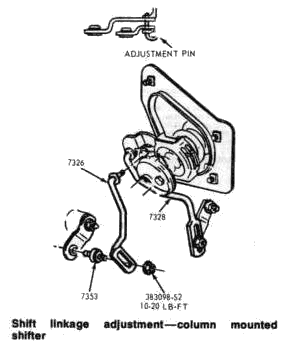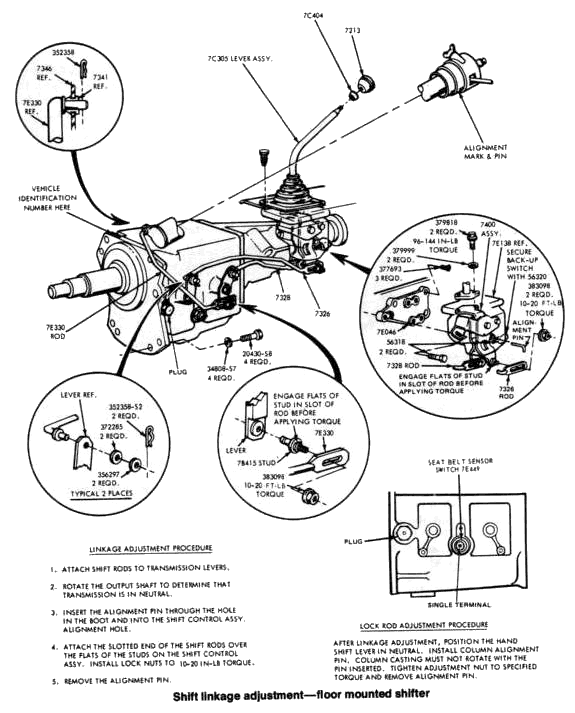Maverick and Comet Repair
Clutch and Transmission
MANUAL TRANSMISSION
The
manual transmission installed in Mavericks and Comets is a Ford
design, top cover 3-speed. All forward gears are fully synchronized,
helical cut and in constant mesh. A column mounted shifter is
standard on all models and floor mounted shifter is optional on
1971-77 models.
The clutch is of conventional design, incorporating a single dry disc, steel spring actuated pressure plate, and release (throw-out) bearing. A 9 in. diameter disc is used on all 170 and 200 six-cylinder engines. A 10 in. diameter disc is used on all 302 V8 engines and on 1973-77 250 six-cylinder engines.
REMOVAL AND INSTALLATION
Removal of the 3-speed manual transmission
is as follows: With the car raised on a lift, mark the driveshaft so
that it can be replaced in its original position relative to the
components to which it is connected. Disconnect the drive shaft from
the U-joint flange at the rear and slide the front of the driveshaft
from the transmission extension housing and off the output shaft.
Install a sealing tool into the extension housing to prevent
lubricant from leaking from the transmission. Remove the capscrew
and lockwasher securing the speedometer retainer to the extension
housing and withdraw the cable from the housing. Disconnect the
transmission controlled spark cable, if so equipped. Remove the
shift rods from the shift levers at the transmission. Raise the rear
of the engine enough to remove the weight from the crossmember.
Remove the crossmember. With the transmission supported, remove the
transmission from the flywheel housing. Push the transmission and
jack to the rear until the input shaft clears the flywheel housing.
The transmission may now be removed from the jack and mounted in a
suitable fixture.
NOTE: Do not depress the clutch pedal while the transmission is removed from the car.
Having ensured that the machined surfaces of the transmission case and flywheel housing are clean and smooth, install the transmission as follows: Install a guide pin into each lower mounting bolt hole. Start the input shaft through the release bearing and line up the splines on the input shaft with those in the clutch disc. Move the transmission forward on the guide pins until the input shaft pilot enters the bearing or bushing on the crankshaft. Should the transmission front bearing retainer bind up on the clutch release bearing hub, work the release bearing lever back and forth until the hub slides freely onto the transmission front bearing retainer. Install the two transmission-to-flywheel housing upper mounting bolts and lockwashers. Remove the two guide pins and install the two lower bolts and lockwashers. Torque the mounting bolts to 37-42 ft. lbs. With the rear of the engine raised high enough to provide clearance, install the crossmember assembly to the frame side supports. Install the gearshift rods to the shift levers at the transmission. Install the speedometer cable and driven gear to the extension housing. Connect the transmission controlled spark cable, if so equipped. Remove the sealing tool from the extension housing and, noting the position marks made prior to removal, slide the driveshaft front universal joint yoke onto the output shaft and into the extension housing. Connect the rear universal joint to the axle pinion flange and tighten the nuts to 10-15 ft. lbs. Fill the transmission with specified lubricant to the proper level and adjust the clutch pedal free-play and the shift linkage if necessary.
LINKAGE ADJUSTMENT
Column Mounted Shifter
With the gearshift in the
Neutral position, loosen the two gearshift rod adjustment nuts and
check to ensure that the shift levers on the transmission are in the
Neutral position. As shown in the accompanying illustration, insert
a 3/16 in. diameter alignment tool through the First and Reverse
gearshift lever, the Second and Third gearshift lever, and through
both holes in the lower casting.
NOTE: A suitable alignment tool can be fashioned from a 3/16 in. drill bit which is bent into an L-shape and which has perpendicular lengths of 1 in. and 2 in. from the elbow. The short end of the tool is inserted into the alignment holes.
With the alignment tool in place, tighten the two gearshift rod adjustment nuts, then remove the tool. With the engine running, operate the shift lever to ensure that it moves freely to each position.

Floor Mounted Shifter
- Loosen the two shift linkage adjustment nuts, making sure that the shift rods remain in the transmission shift levers.
- Rotate the output shaft to determine that the transmission is in Neutral.
- Insert a % in. alignment pin through the hole in the boot and into the shift control assembly alignment hole.
- Attach the slotted ends of the shift rods over the flats of the studs on the shift control assembly. Install and tighten the two shift linkage adjusting locknuts to 10-20 ft. lbs.
- Remove the alignment pin and check the gear lever for smooth crossover.
- Perform a lock rod adjustment.

Transmission Lock Rod
Adjustment
1970 and later models with floor or console
mounted shifters and manual transmissions incorporate a transmission
lock rod which prevents the shifter from being moved from the
Reverse position when the ignition lock is in the OFF position. The
lock rod connects the shift tube in the steering column to the
transmission Reverse lever. The lock rod can not be properly
adjusted until the manual linkage adjustment is correct.
- With the transmission selector lever in the Neutral position, loosen the lock rod adjustment nut on the transmission Reverse lever.
- Insert a .180 in. diameter rod (No. 15 drill bit) in the gauge pin hole located at the 6 o'clock position on the steering column socket casting, directly below the ignition lock.
- Manipulate the pin until the casting will not move with the pin inserted.
- Torque the lock rod adjustment rod to 10-20 ft. lbs.
- Remove the pin and check the linkage operation.